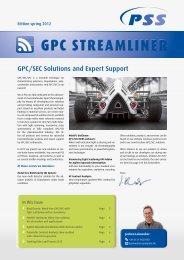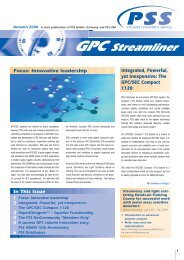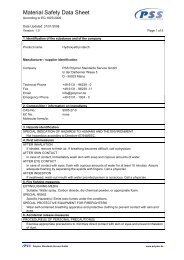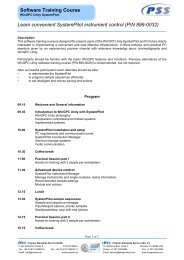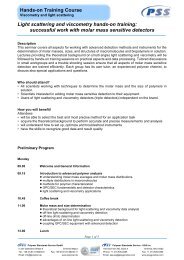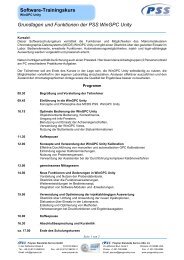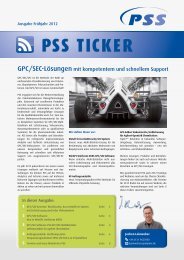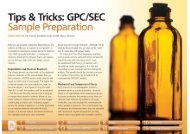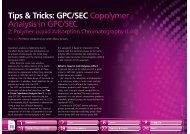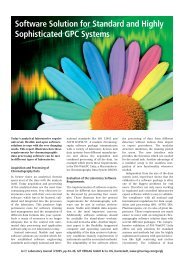GPC Streamliner - PSS
GPC Streamliner - PSS
GPC Streamliner - PSS
You also want an ePaper? Increase the reach of your titles
YUMPU automatically turns print PDFs into web optimized ePapers that Google loves.
July 2004<br />
<strong>GPC</strong> <strong>Streamliner</strong><br />
Polymer Standards Service-USA, Inc. Toll Free: (888) 477-7872 e-mail: pssusa@polymer.de<br />
Special features:<br />
• Win<strong>GPC</strong> Unity<br />
Compact Edition<br />
only available in<br />
USA<br />
• F.Y.I.<br />
Comparative<br />
Overview of Light<br />
Scattering<br />
Detectors<br />
.<br />
<strong>PSS</strong> Achieves Unity in <strong>GPC</strong>-SEC<br />
In this issue we will show our<br />
comprehensive approach to<br />
provide you with a united front<br />
toward efficient cutting-edge<br />
<strong>GPC</strong>-SEC.<br />
Unity is the newest triumph of<br />
Win<strong>GPC</strong> software. WIN<strong>GPC</strong><br />
Unity is a data system that<br />
merges all available methods<br />
applied for size exclusion<br />
chromatography. The software<br />
integrates all detectors into one<br />
environment, independently of<br />
brand, to provide you with every<br />
piece of information within a<br />
single injection. Win<strong>GPC</strong> Unity is<br />
the only program that integrates<br />
all light scattering detectors,<br />
(LS), viscometry detectors, and<br />
conventional detection (UV, RI,<br />
ELSD) simultaneously, in one<br />
run!<br />
With Win<strong>GPC</strong> Unity (and the<br />
appropriate modules), you<br />
measure your sample now and<br />
decide afterwards what data is<br />
relevant to this sample and how<br />
you want to analyze it. In one<br />
injection you can process results<br />
via LS, universal, or conventional<br />
calibration. You will not have to<br />
repeat the run when the<br />
evaluation assumptions were<br />
wrong (e.g., LS molecular<br />
weights are below 5,000 D).<br />
There are no restrictions to<br />
reprocess raw data once it has<br />
been collected.<br />
More on UNITY, page2<br />
Content<br />
<strong>PSS</strong> Quest for Integration with DAWN@LAN /Win<strong>GPC</strong> UNITY LS<br />
Connection with Wyatt Light Scattering Instruments<br />
Software 2<br />
L Scattering 3<br />
SLD7000 6<br />
ReadyCal TM 6<br />
HighSpeed Col. 7<br />
<strong>PSS</strong> Products 7<br />
<strong>PSS</strong> Offer 8<br />
ACS Meeting 8<br />
Here it is! <strong>PSS</strong> has another<br />
solution to embrace instrument<br />
diversity and empower the<br />
scientific world to capitalize on<br />
their investment by truly<br />
integrating all the analytical<br />
elements. This hardware<br />
product, the DAWN@LAN,<br />
enables the hook-up of Wyatt LS<br />
Detectors into the network and<br />
integrates them into an<br />
environment that is compatible<br />
with modern laboratory data<br />
management requirements. You<br />
would need WIN<strong>GPC</strong> Unity with<br />
Win<strong>GPC</strong> MALLS module to use<br />
the LAN Interface.<br />
Going beyond the simplicity of<br />
local data acquisition and standalone<br />
operation, the modern<br />
bottom line dictates that<br />
computers are integrated into<br />
company-wide networks and<br />
digital data travel<br />
instantaneously. While Wyatt's<br />
Light Scattering detectors<br />
currently provide highly searched<br />
information, they demand setups<br />
of isolated islands, which are<br />
difficult to control, maintain and<br />
administer. Wyatt's<br />
instrumentation was not<br />
conducive to incorporation into<br />
modern laboratory infrastructure,<br />
until <strong>PSS</strong> launched the<br />
DAWN@LAN and Win<strong>GPC</strong><br />
UNITY MALLS Module<br />
What is so great about<br />
DAWN@LAN?<br />
First and foremost, it supports all<br />
DAWN protocol features: laser<br />
on/off, Inject trigger, AUX<br />
channels, etc.<br />
This connector (for LAN/WAN<br />
hookups of Wyatt LS Detectors)<br />
is crucial to integrate every Wyatt<br />
light scattering detector into the<br />
network. Using the hook up you<br />
can access the instrument<br />
remotely over the LAN; Capture<br />
data from any accessible<br />
LAN/WAN point within intranet<br />
and extranet; Prevent data loss<br />
through an integrated intelligent<br />
data buffer and; meet security<br />
requirements easily by<br />
separating users from potentially<br />
hazardous environments. It<br />
ships complete with network<br />
cable and power supply
<strong>GPC</strong> <strong>Streamliner</strong><br />
Page 2 of 8<br />
Software Solutions: Win<strong>GPC</strong> UNITY, Compact Edition<br />
“Bird-eye-view lets you<br />
always see what goes on.<br />
Always is up to date.”<br />
ISO, DIN, GLP COMPLIANCE AND<br />
COMPLETE SOFTWARE VALIDATION<br />
WIN<strong>GPC</strong> UNITY MODULES<br />
Client Server: Allows various instruments to be accessible to many users<br />
simultaneously, via network<br />
Triple PLUS detection: multiple<br />
angles for Light scattering, viscosity<br />
and concentration detector(s).<br />
Viscosity: (1, 2, 3 and 4 capillary<br />
bridge designs) Intrinsic viscosity<br />
and Mark-Houwink coefficients &<br />
branching<br />
2-Dimensional Chromatography: Molar mass<br />
and composition distribution-: <strong>GPC</strong>-HPLC;<br />
LC/CAP- <strong>GPC</strong>, RPIC-NPLC, TREF-<strong>GPC</strong>, IC-<strong>GPC</strong>,<br />
<strong>GPC</strong>-GC, <strong>GPC</strong>-CE, and <strong>GPC</strong>-SFC<br />
Light Scattering: LS-One angle<br />
measurement of absolute molar mass<br />
(LALS, RALS) and/or MALLS- multiple<br />
angles for absolute molar mass<br />
branching and radius of gyration.<br />
(MALS, TALLS)<br />
Heparins and End-group<br />
Analysis<br />
Multi Instrument Copolymer: Average chemical composition<br />
Acquisition<br />
Chemical Heterogeneity: HPLC-type separations<br />
Report Designer: Produce eye-catching graphs and documentation for reports<br />
and presentations.<br />
UNITY SEC-<strong>GPC</strong>: Molar Mass averages and distributions Mw, Mp, Mn, D<br />
Win<strong>GPC</strong> UNITY is a Software<br />
Data System for liquid<br />
chromatography of polymers with<br />
focus on Gel Permeation / Size<br />
Exclusion Chromatography.<br />
The Win<strong>GPC</strong> Unity Compact<br />
Edition, an entry-level product of<br />
unparalleled value, is ideal for a<br />
single instrument installation<br />
performing conventional <strong>GPC</strong><br />
analysis with 1 to 3 detectors on<br />
a single PC.<br />
Unity’s market-wide compatibility<br />
allows the use of any detector<br />
RI, UV, ELSD, IR, etc,<br />
regardless of brand. The<br />
software will manage the data<br />
acquisition, data processing,<br />
documentation and results<br />
presentation to provide:<br />
Molecular Weight Distribution<br />
(MWD), Mw, Mp, Mn, and Polydispersity<br />
D. Unity will convert<br />
any HPLC instrument into a <strong>GPC</strong><br />
instrument when you switch to<br />
appropriate columns and<br />
standards. Win<strong>GPC</strong> Unity<br />
salient features include a friendly<br />
interface in the Windows<br />
operating system, which allows<br />
the view of raw data,<br />
chromatograms and calculated<br />
molecular weight distributions<br />
simultaneously; Powerful<br />
chromatogram and molar mass<br />
overlays provide application<br />
versatility; the video strip chart<br />
feature lets you monitor multiple<br />
injections; Unity’s underlying<br />
database design provides<br />
powerful and secure data<br />
storage and retrieval capabilities<br />
that allow re-calibration or data<br />
re-processing; Automated <strong>GPC</strong><br />
processes include: internal<br />
standard, calibration,<br />
recalibration, and reporting.<br />
The optional WIN<strong>GPC</strong> Report<br />
Designer Module enables you to<br />
create custom individual reports<br />
where you control the content<br />
(graphics, results/result tables,<br />
text entries etc.) in a word<br />
processing environment with<br />
formatting, calculations and<br />
number rounding capabilities.<br />
Upgrade the WIN<strong>GPC</strong> Unity<br />
Compact Edition. Add modules<br />
to fit your changing needs,<br />
whether they are to add complex<br />
measurement capabilities to one<br />
instrument or to expand from a<br />
single instrument to large SEC<br />
installations with true clientserver<br />
networks. Case specific<br />
configurations will be discussed<br />
and quoted upon request.<br />
System Requirements:<br />
Pentium, Windows 2000 or XP<br />
40 GB Hard disk<br />
256 or better RAM<br />
RS-232 Com Port<br />
17 in or larger monitor.<br />
Part Number: Description: Price:<br />
Win<strong>GPC</strong>-com1 Data acquisition and processing from 1 detector $4,995<br />
Win<strong>GPC</strong>-com2 Data acquisition and processing from 2 detectors $5,495<br />
Win<strong>GPC</strong>-com3 Data acquisition and processing from 3 detectors $5,995<br />
Win<strong>GPC</strong>RD Report Designer Module $1,295
Page 3 of 8<br />
F.Y.I.<br />
<strong>GPC</strong> <strong>Streamliner</strong><br />
Not all Light Scattering Detectors are created equal!<br />
Comparative Overview by Peter Kilz<br />
The evolution of customer<br />
demands and laboratory<br />
requirements calls for<br />
instrumentation that provides<br />
cost effective high performance,<br />
specifically to meet the needs of<br />
the ever-evolving field of<br />
biopolymer applications. A<br />
review of measuring principles of<br />
Light Scattering (LS) Detectors is<br />
included here to equip the user<br />
with decision-making facts to<br />
select instrumentation. The<br />
following LS detectors are<br />
included: Low Angle LS<br />
(LALLS); Right Angle LS<br />
(RALLS); Two/three Angle LS<br />
(TALLS) and Multi Angle LS<br />
(MALLS). .<br />
Gel Permeation Chromatography<br />
(<strong>GPC</strong> a.k.a. SEC or GFC) is<br />
used to characterize<br />
macromolecules: molecular<br />
weight distribution, structure<br />
distribution, end group and<br />
branching distributions. [1]<br />
When coupled with LS detectors,<br />
more extensive structure<br />
information (branching and<br />
density) is possible even without<br />
calibration with reference<br />
materials. [2a,b,c]. Depending on<br />
the type of LS instrument used,<br />
various qualitative and<br />
quantitative properties can be<br />
determined:<br />
- Radius of gyration (Rg)<br />
- Degree of branching (long<br />
chain branching)<br />
- Changes of the molecular<br />
structure<br />
- Aggregation-/agglomeration<br />
behavior<br />
- Aging/storage processes.<br />
Basic Measuring Principles<br />
Low Angle Laser Light<br />
Scattering (LALLS)<br />
Due to its construction LALLS<br />
has a complicated optical setup<br />
[3a,b] that often results in signal<br />
interference impulses ("Spikes")<br />
when small air bubbles or<br />
particles get into the measuring<br />
cell (Fig. 1). The cell needs to be<br />
cleaned frequently from<br />
sediments that affects the optical<br />
behavior and creates external<br />
scatterings. LALLS does not<br />
deliver values like branching<br />
degree (an angle-dependent<br />
measurement). The LALLS<br />
advantage is the exact<br />
measurement of high molecular<br />
weights (> 10 Million. g/mol) free<br />
from angle extrapolation errors<br />
[4].<br />
Right Angle Laser Light<br />
Scattering (RALLS)<br />
The construction of the LS with<br />
one scattering signal at 90 o<br />
RALLS is very simple and sturdy.<br />
Its signal occurs usually with<br />
minimum interference, but<br />
RALLS produces correct results<br />
only for relatively small molecular<br />
weights: about 200-kg/mol or<br />
molecule sizes smaller than10<br />
nm without additional structural<br />
information. For measurements<br />
of higher molecular weight<br />
samples the LS signal has to be<br />
corrected with a viscosity<br />
detector [5], thus requiring<br />
assumptions, which cannot<br />
easily be verified.<br />
Two-Angle Laser Light<br />
Scattering (TALLS)<br />
From <strong>PSS</strong> experience the use of<br />
Signal [V]<br />
Signal [V]<br />
0.035<br />
0.030<br />
0.025<br />
0.020<br />
0.015<br />
0.010<br />
0.005<br />
0.000<br />
0.40<br />
0.35<br />
0.30<br />
0.25<br />
0.20<br />
0.15<br />
0.10<br />
0.05<br />
0.00<br />
Dextran T-2000<br />
5.5 6.0 6.5 7.0 7.5 8.0 8.5 9.0 9.5<br />
Fig 1 See the interference of the 7 o LALLS-signals (red)<br />
compared to the excellent signal/noise ratio of the RI signal<br />
(green)<br />
two- or three angles LS<br />
instruments does not<br />
considerably improve the<br />
situations mentioned above. The<br />
two-angle LS instruments<br />
operating at 15 o and 90 o often<br />
present both disadvantages of<br />
LALLS- and RALLS instruments<br />
[6]: use assumptions and small<br />
angle signal presents<br />
interference, like those shown on<br />
Figure 2.<br />
The range of angles offered by<br />
the available three-angle<br />
instruments is too small<br />
Eluent: 0.05% NaN3<br />
Column: <strong>PSS</strong> SUPREMA linear XL<br />
Detection: LALLS 7°<br />
RI<br />
Elution volume [ml]<br />
largely branched acrylate<br />
12 14 16 18 20 22 24 26 28<br />
Elution volume [ml]<br />
Eluent: THF p.A.<br />
Column: <strong>PSS</strong> SDV 5µ linear<br />
Detection: PDI 15°<br />
PDI 90°<br />
Figure 2: View of Raw Data of a Two-Angle Light Scattering<br />
Instrument; It shows the lower share of signal interferences<br />
in THF (with a largely branched PMMA); the different<br />
structures can be differentiated in terms of quality, but not<br />
easily in quantity with the TALLS procedure.<br />
RI<br />
<strong>PSS</strong> Win<strong>GPC</strong> scientific V 7.12, Lab_PK, Instanz #1<br />
<strong>PSS</strong> Win<strong>GPC</strong> scientific V 7.12, Lab_PK, Instanz #1
<strong>GPC</strong> <strong>Streamliner</strong> Page 4 of 8<br />
Signal [V]<br />
0.45<br />
0.40<br />
0.35<br />
0.30<br />
0.25<br />
0.20<br />
0.15<br />
0.10<br />
0.05<br />
0.00<br />
17 18 19 20 21 22 23 24 25<br />
Figure 3: Light Scattering and RI Signal of a High-Molecular<br />
Polyacrylate measured with a Three-Angle LS Instrument<br />
Here the susceptibility to interferences of the LS-signals at<br />
small angles is compared with the wider-angle scattering (RI<br />
signal not visible very well in this graph).<br />
Laser<br />
Scattered light<br />
Photo cell<br />
Elution volume [ml]<br />
Figure 4: Schematic setup of commercial MALLS light<br />
scattering cell; shows the light path from the photo cell angle<br />
that deviates from the scattering angle.<br />
Optical fibre<br />
Angle position<br />
cylindrical sample cell<br />
Eluent in<br />
(Eluent in/out: below/over the picture level)<br />
Polyacrylic acid<br />
Fig 5: Setup of the Cylindrical Light Scattering Cell [8b] of<br />
the scattering light instrument <strong>PSS</strong> SLD 7000 MALLS.<br />
A 90 O phase transition leas to a significantly better signal<br />
quality (see Fig. 6)<br />
Comparative Overview (continued)<br />
Eluent: 0.1M NaNO3<br />
Columns: <strong>PSS</strong> SUPREMA 100+1000+3000<br />
Detection: mD 45°<br />
mD 90°<br />
mD 135°<br />
RI<br />
Sample cell<br />
Eluent out<br />
<strong>PSS</strong> Win<strong>GPC</strong> scientific V 7.12, Lab_PK, Instanz #1<br />
(realistically about 50 o to<br />
120 o ) to be able to deliver<br />
independent information<br />
about the structure over an<br />
extensive molecular weight<br />
range. These small angle<br />
instruments usually yield<br />
good quality signals with<br />
interferences comparable to<br />
those of wide-angle<br />
scattering see Figure 3. For<br />
small molecules (isotropic<br />
scattering) TALLS can be<br />
used with similar results to<br />
those of the much less<br />
expensive RALLS detector.<br />
Multi Angle Laser Light<br />
Scattering (MALLS)<br />
The available MALLS<br />
instruments overcome the<br />
limitations of LALS and offer<br />
the best use of LS [7]. The<br />
range of angles available<br />
typically 30 o to 150 o is more<br />
important, than the number<br />
of angles. To obtain an exact<br />
description of most<br />
scattering functions seven<br />
angles are sufficient more<br />
angles become redundant<br />
carrying unnecessary<br />
increases in capital and<br />
operation costs<br />
Quality and stability of the<br />
signals highly depend on the<br />
construction of the<br />
measuring cell. One MALLS<br />
detector uses a glass bloc<br />
with a longitudinal bore.<br />
Figure 4 shows the light<br />
path from the photocell angle<br />
that deviates from the<br />
scattering angle. This design<br />
requires mathematical<br />
corrections to account for the<br />
refraction caused by phase<br />
transition solution-glass,<br />
glass-air, at angles other<br />
than 90 o . This effect is<br />
notorious in small angle<br />
signals, which are subject to<br />
interferences or even rendered<br />
useless for measuring<br />
purposes.<br />
Improvement of the MALLS<br />
Technique<br />
A seven angle LS instrument<br />
has traditional cylindrical-cell<br />
geometry is depicted in Figure<br />
5. The optical fibers are built in<br />
the cell wall at 90° angle. The<br />
right angle phase transition<br />
leads to a great signal quality,<br />
better than the previous<br />
design. The right angle<br />
prevents light refraction effects<br />
and minimizes the share of<br />
external light [8], leading to<br />
high signal/noise ratios and<br />
excellent signal forms. This<br />
self-venting, cylindrical cell has<br />
small dead volume and highpressure<br />
stability (35 bar).<br />
The <strong>GPC</strong> analysis of a paint<br />
binding agent system with the<br />
light scattering Instrument <strong>PSS</strong><br />
SLD 7000 is shown in Fig. 6.<br />
It presents a direct comparison<br />
of the raw signals at 35 o , 90 o<br />
and 145 o and the<br />
concentration detector signal.<br />
The multi-modal paint-binding<br />
agent covers a wide molecular<br />
weight range (10 million up to<br />
1000 g/mol). The black curve<br />
shows a reliable measurement<br />
of the molecular weight even<br />
for the relatively small<br />
concentration and molecular<br />
weight. In the high-molecular<br />
range the quality of the raw<br />
signals is very good, below<br />
about 10 kg/mol a slight noise<br />
can be detected. This is due to<br />
the used measuring principle<br />
since the strength of the LS<br />
signal is proportional to the<br />
concentration and the<br />
molecular weight. When both<br />
factors are small their product<br />
is very small and therefore the<br />
signal/noise ratio will naturally<br />
d
Page 5 of 8<br />
<strong>GPC</strong> <strong>Streamliner</strong><br />
Comparative Overview (continued)<br />
Conclusions<br />
The light scattering detection in<br />
<strong>GPC</strong> can lead to considerably<br />
more information when various<br />
angles are measured. Therefore<br />
MALLS provide a more complete<br />
approach to maximizing the<br />
information. Seven<br />
simultaneous angles measured<br />
with minimum interference,<br />
maximum sensitivity and<br />
reliability place the <strong>PSS</strong> SLD<br />
7000 in a leading position within<br />
the market. The high<br />
performance <strong>PSS</strong> SLD 7000<br />
instrument operates with the<br />
<strong>PSS</strong> Win<strong>GPC</strong>, an efficient<br />
flexibly and expandable software<br />
solution that smoothly fits into<br />
the existing laboratory<br />
environment and delivers fast<br />
and sound answers on actual<br />
questions about natural,<br />
synthetic and (bio) polymers.<br />
References:<br />
Sci. Polym. Chem. Ed. 1974, 12,<br />
1151<br />
b) M. Haney, Book of Abstracts, Int'l<br />
MM Symposium, p.20, Amsterdam.<br />
2003<br />
[4]M. Anderson, K.G. Wahlund, B.<br />
Wittgren, Book of Abstracts, Int'l MM<br />
ymposium, p. A19, Amsterdam. 2003<br />
[5]W. Yau, ChemtractsMacromol.<br />
Chem. 1, 1 (1990)<br />
[6]T.H. Mourey, H. Coll, J. Appl.<br />
Polym. Sci., 56, 65 (1995)<br />
[7]a)C. Jackson, H.G. Barth, In: C.S.<br />
Wu (Ed.) Molecular Weight Sensitive<br />
Detectors for Size Exclusion<br />
Chromatography, Chapter 4, Marcel<br />
Dekker, New York, 1995<br />
C. Jackson, H.G. Barth, Trends Polym.<br />
ci., 2, 203 (1994)<br />
[8]a) F. Florenzano, R. Strelitzki, W.<br />
F. Reed, Macromolecules, 31, 7226<br />
Signal [V]<br />
0.9<br />
0.8<br />
0.7<br />
0.6<br />
0.5<br />
0.4<br />
0.3<br />
0.2<br />
0.1<br />
0.0<br />
Mw (LS)<br />
Paint Binding Agent system<br />
10 8<br />
10 7<br />
Eluent: THF, p.a.<br />
Columns: <strong>PSS</strong> SDV5µ lin + 100Å<br />
10 6<br />
Detection: SLD7000 35°<br />
SLD7000 90°<br />
10 5<br />
SLD7000 135°<br />
RI<br />
10 4<br />
10 3<br />
10 2<br />
15.0 17.5 20.0 22.5 25.0 27.5 30.0 32.5<br />
Elution volume [ml]<br />
Fig 6: <strong>GPC</strong>-Analysis of a Paint Binding Agent System with<br />
the Light Scattering Instrument <strong>PSS</strong> SLD 7000 in THF<br />
<strong>PSS</strong> Win<strong>GPC</strong> scientific V 7.12, Lab_PK, Instanz #1<br />
[1]S. Mori, H.G. Barth: Size Exclusion<br />
(1998)<br />
Chromatography; Springer, Berlin,<br />
1999<br />
[2]a)H.G. Barth, J.W. Mays: Modern<br />
Methods of Polymer Characterization;<br />
Wiley: New York, 1991<br />
b)W. Reed, US Patent 6,052,184<br />
[9]a)T. Hofe, H. Königsmann,<br />
Lichtstreuung an Polymeren, ohne<br />
Kenntnis von dn/dc ein Lotteriespiel?,<br />
GIT Fachz. Lab., 47, Heft 4 (2003)<br />
b) H.G. Barth, "Hyphenated Polymer<br />
(im Druck)<br />
Separation Techniques. Present and<br />
Future Role". In: T. Provder, H.G.<br />
Barth, M.W. Urban (Eds.),<br />
Chromatographic Characterization of<br />
Polymers. Hyphenated and<br />
Multidimensional Techniques,<br />
Chapter 1, Adv. Chem. Ser. 247,<br />
American Chemical Society,<br />
Washington, DC, 1995<br />
c) C. Jackson, H.G. Barth, In: C.S.<br />
Wu (Ed.) Molecular Weight Sensitive<br />
Detectors for Size Exclusion<br />
Chromatography, Chapter 4, Marcel<br />
b)P. Kratochvil, In: A.D. Jenkins (Ed.)<br />
Classical Light Scattering from<br />
Polymer Solutions, Polym. Sci. Libr.<br />
5, Elsevier, Amsterdam, 1987<br />
[10]D. Held, Neue Möglichkeiten mit<br />
neuartigen online<br />
Mehrwinkellichtstreudetektoren,<br />
Proceedings Incom Symposium,<br />
Düsseldorf, 2003; online edition:<br />
www.incomsymposium.de/InCom200<br />
3/Inhalt/send_Tagungsband_Lang?<br />
schluessel=20<br />
New instrumentation<br />
provides you choices<br />
Best Value in the<br />
Market!!<br />
Dekker, New York, 1995<br />
[3] a) A.C. Ouano, W. Kaye, J. Polym.
<strong>GPC</strong> <strong>Streamliner</strong> Page 6of 8<br />
<strong>PSS</strong> SLD7000 Instrument features<br />
Relevance: simultaneous<br />
measurement of seven angles<br />
between 35 o and 145 o .<br />
Reliability: by optimized flowing<br />
paths and separated<br />
optics/electronics: self-venting,<br />
cylindrical measuring cell with<br />
index matching, small dead<br />
volume and high-pressure<br />
stability (35 bar).<br />
Sensitivity: ultra-sensitive CCD<br />
detector and the optical fiber<br />
technique.<br />
Accuracy and precision:<br />
resulting from extremely small<br />
scattering volume (20 µl) low<br />
noise and minimal scattered<br />
light.<br />
High signal quality: small cell<br />
volume (50 µl) prevents band<br />
broadening and other artifacts;<br />
USB data transfer.<br />
Easy handling: plug and play<br />
operation: seamless Win<strong>GPC</strong><br />
Unity integration with multiple<br />
systems and detectors (e.g.<br />
viscosity).<br />
Flexibility: can be used as<br />
detector or as a stand-alone LS<br />
instrument.<br />
Compact design: optimized<br />
instrument design taking<br />
advantage of all known<br />
miniaturizing concepts.<br />
ReadyCal TM Kits<br />
This product allows you to<br />
prepare a 12-point calibration<br />
curve within minutes, without the<br />
mess of weighing. Just add<br />
solvent to three vials, one of<br />
each color; let it stand for two<br />
hours, shake gently and load into<br />
your auto-sampler for analysis.<br />
Each kit contains 30 auto<br />
sampler vials that are color<br />
coded for your convenience (10<br />
calibration curves). The kit<br />
comes with a quality certificate<br />
with all information you need.<br />
Available in two auto-sampler<br />
vial sizes: 4ml and 1.5ml - same<br />
price - just specify size when<br />
ordering<br />
“12 point calibration<br />
curve in 3 injections”<br />
The Following ReadyCal Kits are available:<br />
Description MW Range (D) Content Part Number Price<br />
Poly(styrene) ReadyCal 1.5ml 400 - 3,000,000 10x3 vials <strong>PSS</strong>-pskitr1 $ 375<br />
Poly(styrene) ReadyCal 1.5 Low 162 - 70.000 10x3 vials <strong>PSS</strong>-pskitr1l $ 450<br />
Poly(styrene) ReadyCal 1.5 High 1.500 - 6.500.000 10x3 vials <strong>PSS</strong>-pskitr1h $ 450<br />
PMMA ReadyCal1.5 500 - 3,000,000 10x3 vials <strong>PSS</strong>-mmkitr1 $ 425<br />
PEO/PEG ReadyCal 200 - 1,200,000 10x3 vials <strong>PSS</strong>-peokitr1 $ 425
Page 7 of 8<br />
HighSpeed Columns<br />
<strong>GPC</strong> <strong>Streamliner</strong><br />
0.040<br />
0.035<br />
The <strong>PSS</strong> HighSpeed family of<br />
ten minutes; (Polystyrene 374 to<br />
0.030<br />
columns permits dramatic<br />
reductions in <strong>GPC</strong> analysis time<br />
for polymers > 2000D, without<br />
loss in resolution, accuracy or<br />
2.3Million D shown below).<br />
Optimum column design helps<br />
expedite product screening,<br />
process control, and rapid<br />
Spannung [V]<br />
0.025<br />
0.020<br />
0.015<br />
reproducibility. <strong>PSS</strong> HighSpeed<br />
columns (20mmx50mm) have a<br />
larger diameter and a shorter<br />
length than their typical analytical<br />
counterparts (8mm x 300mm),<br />
and the ability to operate at<br />
optimum flow rates of 6.25<br />
ml/min while keeping same linear<br />
flow, equal resolution and<br />
polymer information: Mw, Mn,<br />
Mp and PDI. They have<br />
unparalleled ability to produce a<br />
12 point calibration curve in just<br />
sample throughput.<br />
These columns can substitute<br />
the analytical columns without<br />
modifications to your LC system,<br />
as long as your pump and<br />
detectors can accommodate<br />
6.25 ml/min. At this flow rate,<br />
you will use the same amount of<br />
solvent you currently use, but<br />
your elution occurs quicker. Our<br />
claim is not that you will save<br />
eluent, but that you will save<br />
precious time.<br />
0.010<br />
0.005<br />
0.000<br />
1 2 3 4 5 6 7 8 9 10 11<br />
Elutionszeit [min]<br />
2 4 6 8 10<br />
Elution Time (minutes)<br />
Real Time Calibration Curve with Polystyrene ReadyCal<br />
Standards on a SDV HighSpeed column<br />
Detector UV Flow rate 6.25ml/min (THF)<br />
<strong>PSS</strong> Win<strong>GPC</strong> scientific V 4.02<br />
HighSpeed Columns Applicability Example Eluent Mw Range<br />
GRAL/GRAM PMMA, Dextran, Cellulose nitrate DMF, DMAc, NMP, DMSO 2000 to 1Million<br />
MCX 10µm or 20µm Sulfonates Apple juice Aqueous 2000 to 5Million<br />
NOVEMA Polycations, Proteins PolyDADMAC Aqueous 2000 to 5Million<br />
PFG 7µm, Polyethylene-terephthalate, Nylon HFIP 2000 to 10Million<br />
POLEFIN Polyolefin’s TCB < 8 Million<br />
SDV HR 3µm Oligomers THF, Toluene, CHCl3 2000 to 1Million<br />
SDV 5µm Organic soluble polymers PS, PMMA THF, Toluene, CHCl3 2000 to 10Million<br />
SDV 10µm or 20µm Organic soluble polymers PS, PMMA T HF, Toluene, CHCl3 2000 to 50 Million<br />
SUPREMA 10 or 20µm Gelatin, Bio-polymers, Dextrans Aqueous 2000 to >100 million<br />
<strong>PSS</strong> Product Selection Overview<br />
Our comprehensive product line<br />
includes:<br />
• Reference Polymer Standards<br />
and Calibration Kits that support<br />
the highest standards of quality:<br />
ISO, DIN, EN, ASTM, GLP,<br />
Organic or aqueous.<br />
• <strong>GPC</strong>/SEC Columns and<br />
Specialty Gels.<br />
• <strong>PSS</strong> HighSpeed columns that<br />
increase your sample throughput<br />
up to ten fold.<br />
• Win<strong>GPC</strong> UNITY, a <strong>GPC</strong> Data<br />
System that integrates all your<br />
LC instrumentation into one<br />
environment, works well<br />
with all brands and grows<br />
with your needs<br />
• <strong>GPC</strong> Instruments,<br />
Viscometry and Light<br />
Scattering Detectors<br />
• Contract Laboratory<br />
Services.<br />
• Method Development<br />
• Consulting and Training<br />
• Solutions for custom made<br />
polymers; custom stationary<br />
phases and/or software
Polymer Standards<br />
Service-USA, Inc.<br />
43 Jefferson Blvd. Suite 3<br />
Warwick, RI 02888<br />
PHONE:<br />
(401) 780 8884<br />
FAX:<br />
(401) 780-8824<br />
E-MAIL:<br />
pssusa@polymer.de<br />
We’re on the Web!<br />
See us at:<br />
www.polymer.de<br />
<strong>PSS</strong>-USA 10th Year Anniversary Offer<br />
We are celebrating our 10 th year<br />
Anniversary with a wonderful<br />
10% discount on all our High<br />
Throughput items. So try our<br />
HighSpeed products to enhance<br />
your <strong>GPC</strong>.<br />
<strong>PSS</strong> will continue to work with<br />
you side by side providing high<br />
quality products, cutting edge<br />
expertise, up-to date equipment,<br />
instrumentation and methods<br />
development; whatever it takes<br />
to help you succeed with macro<br />
molecular characterization.<br />
10% off High throughput items<br />
Anniversary Offer<br />
One coupon per customer – expires 8/31/04 AD#UE41<br />
Polystyrene and PMMA ReadyCal standards; add<br />
solvent to ready made mixtures and obtain a 12 point<br />
calibration curve in three injections<br />
High Speed <strong>GPC</strong> Columns; complete analysis in 3<br />
minutes<br />
Win<strong>GPC</strong> Unity software is easy to use; highly<br />
automated; overlaid injections increases sample<br />
throughput by as much as 50%; works with all<br />
instruments and detectors.<br />
Special pricing on SLD7000 Light Scattering Detector<br />
and ETA2010 Viscometer. Mention this add.<br />
Call NOW 1-888-477-7872 to take advantage.<br />
<strong>GPC</strong>/SEC Training Workshops at ACS Fall Meeting in Philadelphia, PA<br />
You are cordially invited to participate in the <strong>GPC</strong>/SEC workshops that will be offered in the upcoming ACS<br />
Fall National Meeting & Exposition on August 23-25, 2004, in Philadelphia, PA. Dr. Martina Adler & Dr.<br />
Gunter Reinhold will offer an “Introduction to Size Exclusion Chromatography,” ideal for beginner or<br />
intermediate practitioners. This workshop will have emphasis on column selection, conventional calibration,<br />
molar mass sensitive detectors, light scattering, viscometry and high-throughput methods. For the more<br />
seasoned person, Dr. Martina Adler and Dr. M. Nazeem Jahed will offer the workshop titled “Recent<br />
Advances in <strong>GPC</strong>/SEC and 2-Dimensional Chromatography” that will focus on method development and<br />
recent applications of 2-D Chromatography (LACCC-<strong>GPC</strong>, HPLC-<strong>GPC</strong>). Those interested may register or<br />
request further information on time, date, and location, via email (pssusa@polymer.de). Late registrations<br />
will be entertained in the <strong>PSS</strong> Booth 319-321, contingent upon space available.<br />
POLYMER STANDARDS SERVICE USA, INC<br />
43 Jefferson Blvd. Suite 3<br />
Warwick, RI 02888<br />
Return Service Requested



